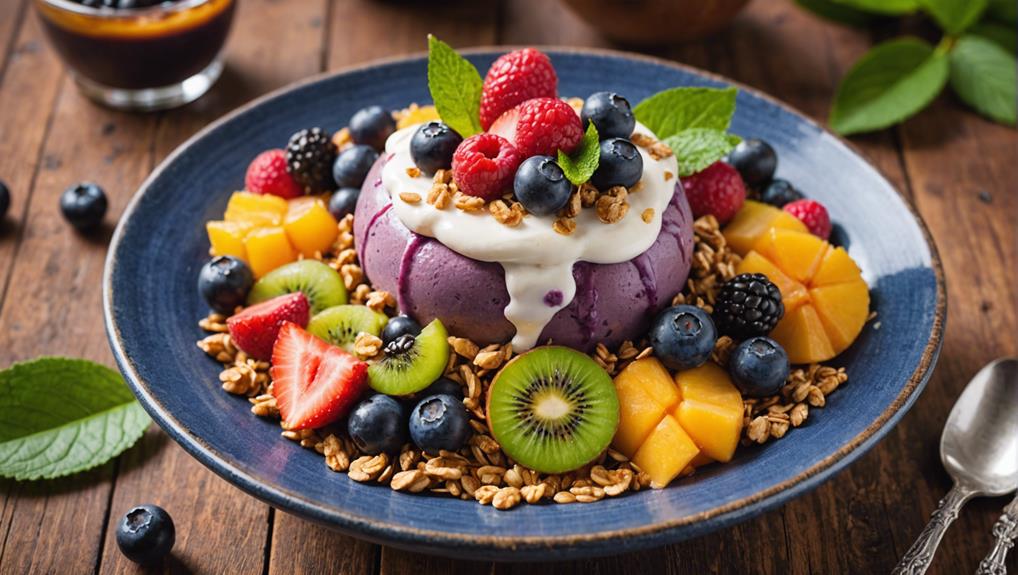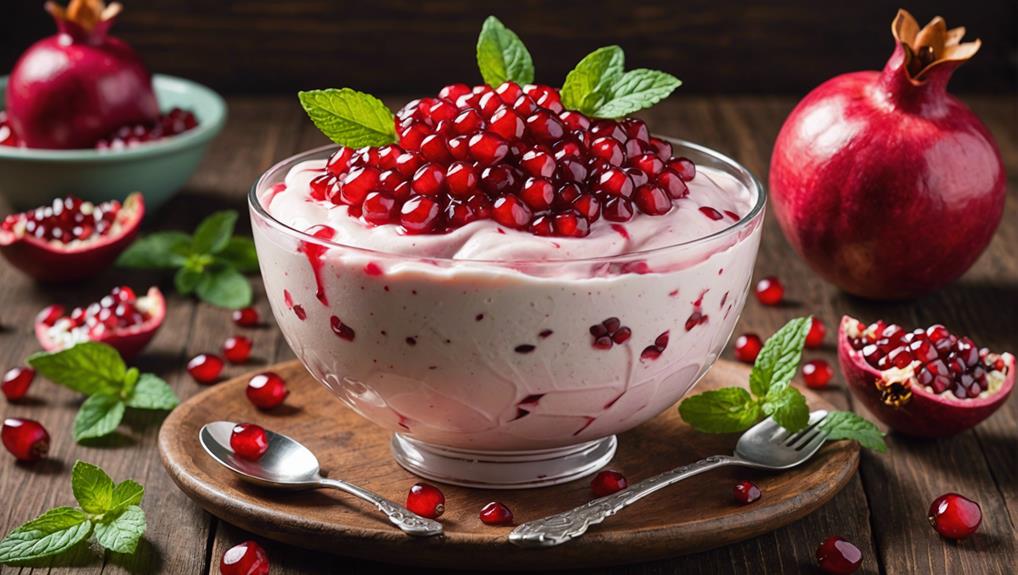Tamarind frozen yogurt is a uniquely tart treat that combines the citrusy tang of tamarind with the creamy texture of yogurt. To craft this delicious dessert, start with high-quality tamarind pulp, blending it with Greek or regular yogurt for a rich, creamy base. Sweeteners like honey or agave syrup balance the tartness, while spices such as cinnamon and cardamom add depth. This treat is not only a flavorful indulgence but also a nutritious option, rich in essential vitamins and digestive benefits. Pair it with fresh fruits or crunchy toppings for a gourmet experience. Curious about the complete process? Keep going to master this delightful creation.
Key Takeaways
- Use high-quality tamarind pulp for authentic tartness and complex flavor.
- Choose Greek yogurt for a rich, creamy texture that enhances tamarind's tanginess.
- Sweeten with honey, agave nectar, or maple syrup to balance the tartness.
- Continuously stir while freezing to incorporate air and achieve a light, creamy consistency.
- Garnish with fresh fruits, toasted coconut flakes, and a drizzle of honey for a gourmet touch.
Benefits of Tamarind
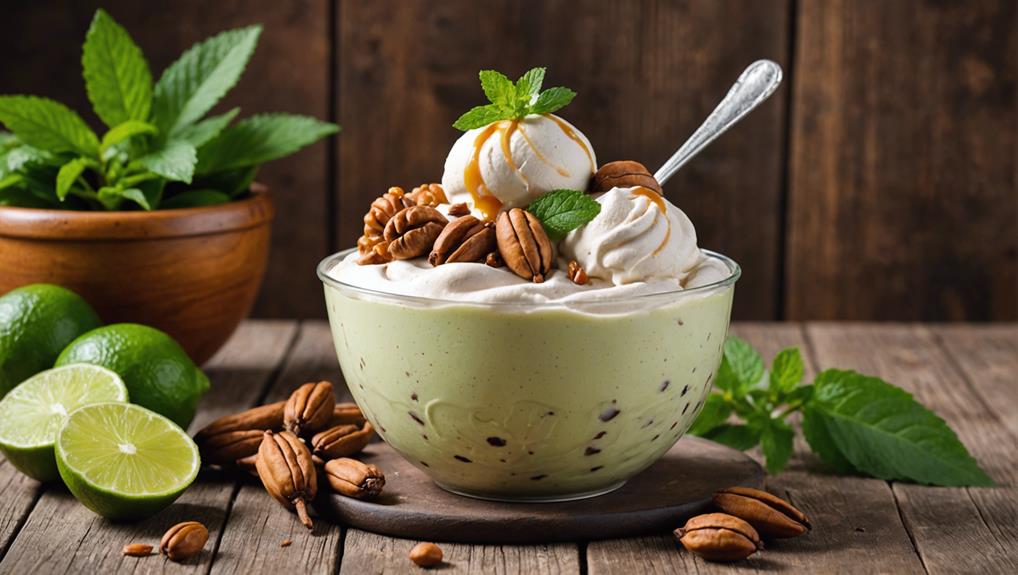
Tamarind, often celebrated for its unique tangy flavor, offers a plethora of health benefits that make it a valuable addition to any diet. Rich in important nutrients, tamarind nutrition includes an impressive array of vitamins and minerals such as vitamin C, vitamin B, potassium, magnesium, and iron. These essential nutrients contribute to overall well-being and support various bodily functions, making tamarind a nutrient-dense food choice.
One of the most notable advantages of tamarind is its significant digestive benefits. Tamarind contains natural dietary fibers that promote healthy digestion by facilitating smoother bowel movements and preventing constipation. Additionally, tamarind is known to stimulate the production of bile, which aids in the efficient breakdown of food, particularly fats. This process not only enhances nutrient absorption but also helps maintain a healthy digestive tract.
Moreover, tamarind's anti-inflammatory and antioxidant properties play an important role in protecting the gut lining from damage and reducing the risk of gastrointestinal disorders. The presence of tartaric acid, a potent antioxidant, further underscores tamarind's ability to combat oxidative stress and improve digestive health.
Choosing the Right Yogurt
Selecting the perfect yogurt is essential for achieving the ideal flavor and consistency in your tamarind frozen yogurt. Opt for Greek yogurt if you prefer a richer, creamier texture, or choose regular yogurt for a lighter, more tangy profile. Balancing these factors will guarantee a delectable treat that perfectly complements the tangy, sweet essence of tamarind.
Yogurt Type Options
Choosing the perfect yogurt for your tamarind frozen yogurt recipe involves considering a variety of factors, such as texture, flavor, and fat content. The type of yogurt you select can greatly influence the final outcome, providing a personalized touch to this unique, tangy treat.
For those with dietary restrictions or preferences, dairy alternatives offer excellent options. Non-dairy yogurts, made from almond, coconut, or soy milk, can yield a creamy and delightful base. Almond milk yogurt provides a subtle, nutty undertone, while coconut milk yogurt adds a rich, tropical flair that complements the tartness of tamarind beautifully. Soy milk yogurt, known for its smooth consistency, can also be an ideal choice, offering a neutral backdrop that allows the tamarind's flavor to shine.
On the other hand, traditional dairy yogurts, such as Greek yogurt, deliver a thick and luxuriant texture, perfect for creating a rich, velvety frozen dessert. Greek yogurt's high protein content and slight tanginess enhance the overall experience, making it a popular choice. Regular whole milk yogurt, with its balanced creaminess and mild taste, also serves as a versatile option, ensuring a harmonious blend with the tamarind's distinctive tartness.
Selecting the appropriate yogurt type ensures your tamarind frozen yogurt is both delicious and tailored to your dietary needs and flavor preferences.
Flavor and Consistency
The interplay between flavor and consistency is essential in crafting the ultimate tamarind frozen yogurt, as it directly affects the satisfaction and enjoyment of each bite. To achieve the perfect flavor balance, choosing the right type of yogurt is key. Greek yogurt, for instance, is renowned for its rich and creamy texture, which harmonizes beautifully with the tartness of tamarind. Its inherent tanginess also enhances the overall flavor profile, creating a delightful contrast that keeps your palate engaged.
On the other hand, regular yogurt offers a lighter, smoother consistency, providing a more subtle backdrop that allows the tamarind's unique taste to shine. The key is to strike a balance where neither the yogurt nor the tamarind overpowers the other, ensuring a harmonious blend that is both invigorating and indulgent.
Texture variation is another important consideration. The creamy body of Greek yogurt can lend a luscious mouthfeel, while the lighter consistency of regular yogurt can result in a more airy and delicate texture. Experimenting with different types of yogurt allows you to tailor the frozen treat to your specific preferences, ensuring that each spoonful delivers a perfect blend of flavor and texture.
Essential Ingredients
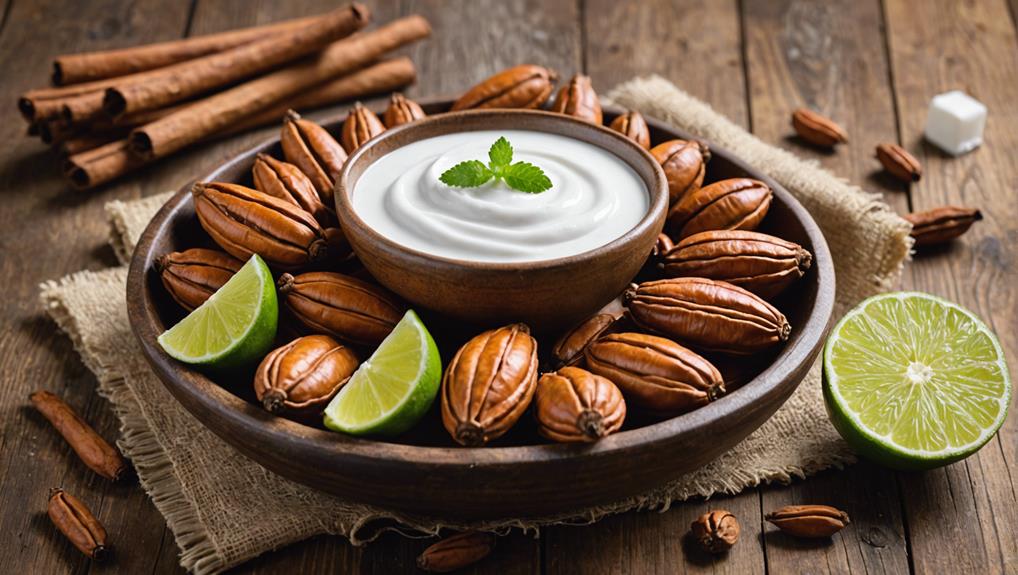
The success of your tamarind frozen yogurt hinges on the quality and selection of key ingredients. First and foremost, sourcing authentic tamarind pulp imparts the signature tangy flavor, while selecting the right type of yogurt guarantees a creamy texture. Additionally, understanding your sweetener options enables you to balance the tartness to perfection.
Tamarind Pulp Source
One of the key ingredients for making the perfect tamarind frozen yogurt is high-quality tamarind pulp, which can be sourced from specialty food stores or online retailers. Tamarind sourcing is critical to achieving the authentic tartness and complex flavor profile that sets this dessert apart. When selecting tamarind pulp, look for products that contain minimal additives and preservatives, ensuring a pure and unadulterated taste.
Specialty food stores often carry tamarind pulp in various forms, such as blocks, concentrate, or ready-to-use paste. Each form offers different advantages; for instance, blocks can be soaked and strained for a more natural, homemade touch, while paste or concentrate can save time without compromising on flavor. Online retailers also provide a convenient way to explore various brands and read reviews, helping you make an informed choice.
For those who may have difficulty finding tamarind pulp, there are pulp alternatives available. Tamarind paste, for example, is a more accessible option that still delivers on flavor. Additionally, some adventurous chefs might experiment with mixing tamarind concentrate with a bit of water to create a pulp-like consistency. Regardless of the form you choose, the essence of tamarind will truly enhance your frozen yogurt creation.
Yogurt Type Choice
Choosing the appropriate type of yogurt is essential for creating a tamarind frozen yogurt that features both a creamy texture and delightful tartness. Greek yogurt is a fantastic choice for this recipe, as its thick consistency and high protein content provide a rich and satisfying base. The natural tanginess of Greek yogurt complements the tartness of tamarind, resulting in a harmonious blend that is both invigorating and decadent. Opting for a full-fat variety can further enhance the creaminess, though low-fat and non-fat options are also viable for those seeking a lighter treat.
For those adhering to plant-based diets, vegan yogurt is an excellent alternative. Made from sources such as almond, coconut, or soy, vegan yogurt not only caters to dietary preferences but also brings unique flavors and textures to the mix. Coconut-based vegan yogurt, for instance, offers a luscious creaminess that pairs exceptionally well with the tangy tamarind, while almond-based varieties lend a subtle nutty undertone. It is essential to select unsweetened versions to maintain control over the sweetness levels in your tamarind frozen yogurt.
Sweetener Options Explained
Enhancing the natural tartness of tamarind while achieving the perfect sweetness balance can be accomplished through a variety of sweetener options, each offering unique characteristics and benefits. Whether you prefer natural sweeteners or artificial sweeteners, the choice can have a substantial impact on the overall flavor and texture of your tamarind frozen yogurt.
Natural sweeteners like honey, agave nectar, and maple syrup bring their own distinctive flavors and health benefits. Honey, for instance, adds a rich, floral note, while agave nectar offers a mild, neutral sweetness. Maple syrup, on the other hand, introduces a deep, caramel-like taste that complements tamarind's tartness wonderfully.
Artificial sweeteners, such as stevia, sucralose, and aspartame, provide a low-calorie alternative that can be ideal for those watching their sugar intake. Stevia, derived from plant leaves, is particularly popular for its natural origin and zero-calorie content. Sucralose and aspartame, meanwhile, are widely used for their intense sweetness and stability when frozen.
| Sweetener | Type | Characteristics |
|---|---|---|
| Honey | Natural Sweetener | Rich, floral notes |
| Stevia | Artificial Sweetener | Zero-calorie, plant-derived |
| Maple Syrup | Natural Sweetener | Deep, caramel-like taste |
Preparing Tamarind Pulp
To prepare tamarind pulp, start by soaking the tamarind pods in warm water to soften the fibrous fruit and release its tangy flavor. This step is vital for achieving that signature tartness that makes tamarind such a unique ingredient. Allow the pods to sit in the water for about 30 minutes, ensuring they become pliable and easy to handle. Once softened, break apart the pods, extracting the seeds and fibrous strings to leave behind the luscious pulp.
Next, transfer the softened tamarind into a fine-mesh strainer placed over a bowl. Using the back of a spoon, press and strain the mixture to separate the rich, thick tamarind pulp from any remaining seeds or fibers. This straining process is essential for achieving a smooth consistency, free of any gritty texture that could interfere with the creamy nature of the frozen yogurt.
The resulting tamarind pulp should be thick and paste-like, with a robust, tangy flavor. Its consistency should be smooth enough to blend seamlessly with the yogurt base, yet dense enough to impart a concentrated burst of tamarind's distinctive taste. This carefully prepared tamarind pulp will serve as the flavorful foundation for your delightful frozen dessert.
Mixing the Yogurt Base
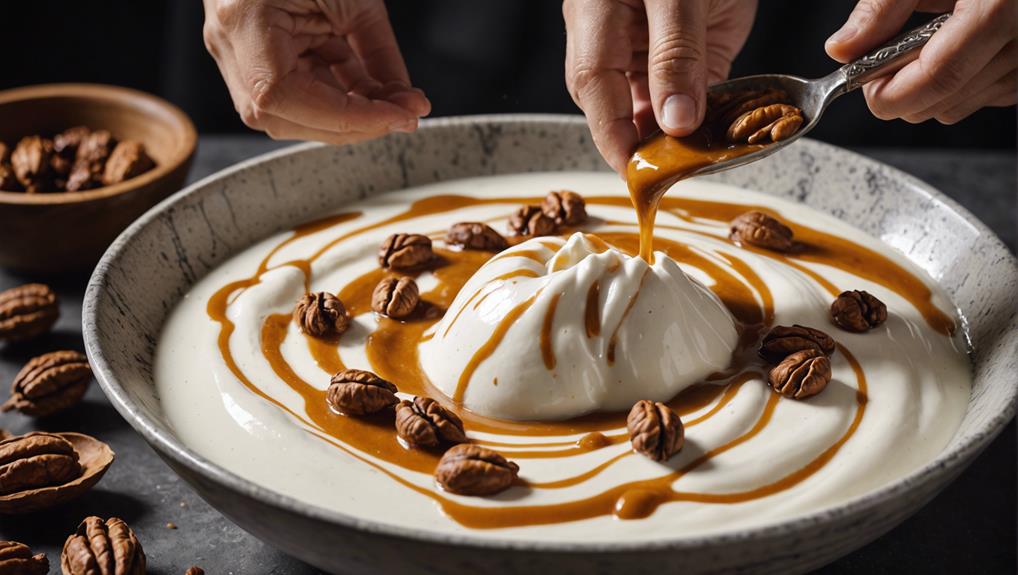
Establishing the yogurt base is a pivotal step that sets the stage for the rich, creamy texture and harmonious flavors of your tamarind frozen yogurt. The foundation begins with selecting high-quality plain yogurt, preferably full-fat to guarantee a luxuriant mouthfeel. For an ideal texture, it is essential to strain the yogurt using a cheesecloth or fine mesh sieve to remove excess whey, resulting in a thicker, creamier consistency.
Blending techniques play an important role in achieving a smooth and cohesive yogurt base. You will need to whisk the strained yogurt until it reaches a uniform texture, free from lumps. This process can be accomplished either manually with a balloon whisk or using an electric mixer on a low setting to maintain control over the consistency.
Texture variations can be introduced by incorporating additional ingredients at this stage, such as a small amount of cream or milk for a silkier texture. However, care must be taken to blend these additions thoroughly to avoid curdling or separation.
With the yogurt base prepared to perfection, it is now ready to embrace the tart and tangy tamarind pulp, setting the stage for a delightful frozen treat.
Adding Sweeteners and Flavors
Infusing the yogurt base with sweeteners and flavors is an essential step that elevates the tamarind frozen yogurt from simply tasty to truly extraordinary. To achieve the perfect balance, blending the tartness of tamarind with appropriate sweeteners and complementary flavors is key. Utilizing alternative sweeteners such as honey, agave syrup, or coconut sugar can offer a healthier twist while maintaining the desired sweetness. Additionally, integrating a mix of spices and fruits can create a symphony of flavor combinations that enhance the yogurt's appeal.
Consider the following tips to craft a memorable tamarind frozen yogurt:
- Honey or Agave Syrup: These natural sweeteners blend seamlessly with tamarind, adding a floral note without overpowering the yogurt.
- Coconut Sugar: This alternative sweetener introduces a subtle caramel-like flavor that pairs beautifully with tamarind's tartness.
- Cinnamon and Cardamom: A dash of these spices can add warmth and depth to the frozen yogurt, creating a complex flavor profile.
- Mango or Pineapple: Mixing in tropical fruits can amplify the yogurt's invigorating quality while balancing the tartness.
- Vanilla Extract: A touch of vanilla can round out the flavors, providing a smooth and creamy finish.
Churning the Yogurt
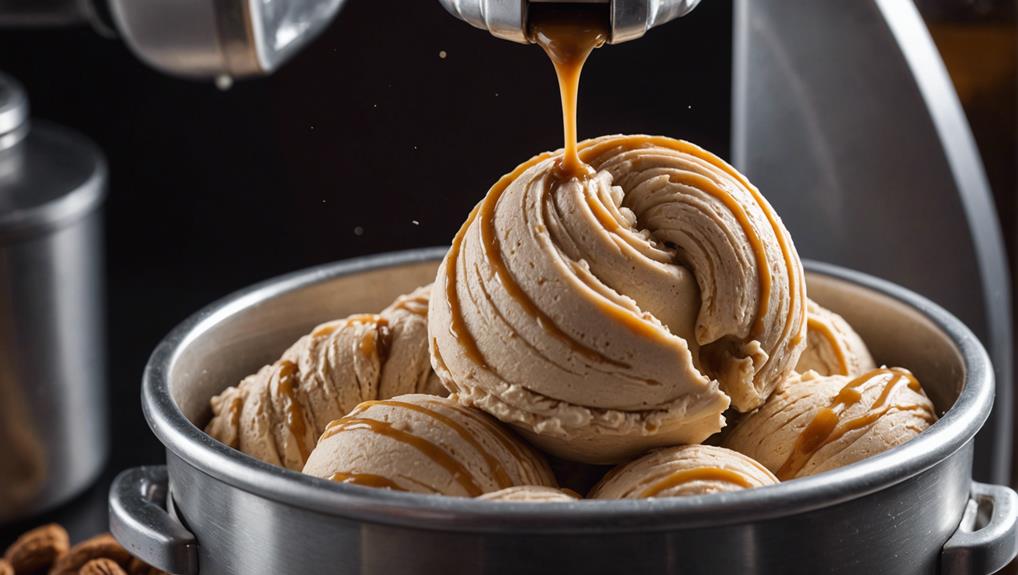
Churning the yogurt is an essential step that guarantees a smooth and creamy texture, transforming the infused yogurt base into a delightful frozen treat. Effective churning techniques are vital in minimizing the formation of ice crystals, ensuring that the tamarind frozen yogurt maintains its luscious consistency.
During the churning process, the yogurt base is continuously stirred while being frozen. This method helps incorporate air into the mixture, creating a light and fluffy texture. The key to successful churning lies in maintaining a consistent temperature and speed, allowing the yogurt to freeze evenly without large ice crystals forming.
To visualize the churning process, consider the following:
| Churning Techniques | Benefits |
|---|---|
| Continuous Stirring | Incorporates air, ensuring a smooth texture |
| Consistent Temperature | Prevents large ice crystals from forming |
| Even Freezing | Maintains creamy consistency throughout |
| Ingredients | Preparation |
| Tamarind Yogurt Base | Infused and chilled |
| Ice Cream Maker | For precise churning |
| Final Product | Result |
| Tamarind Frozen Yogurt | Smooth, tart, and creamy |
Employing these churning techniques ensures the tamarind frozen yogurt achieves the perfect balance of tangy flavor and creamy texture. The meticulous process not only enhances the overall mouthfeel but also elevates the tamarind's unique tartness, making each bite a revitalizing experience.
Freezing and Storing
Once the yogurt has been expertly churned to achieve its smooth and creamy texture, the next step is to properly freeze and store the tamarind frozen yogurt to preserve its delightful consistency and flavor. This essential phase guarantees that the yogurt maintains its tart and invigorating appeal.
To begin, transfer the freshly churned yogurt into proper containers. Opt for airtight, freezer-safe containers to prevent ice crystals from forming, which can significantly impact texture. Make sure to leave some space at the top, as the yogurt will expand when frozen. The next step is to set your freezer temperature to the ideal setting, ideally at or below 0°F (-18°C), to ensure a firm yet scoopable consistency.
To further enhance your tamarind frozen yogurt experience, consider the following tips:
- Label containers with the date of preparation to keep track of freshness.
- Divide into smaller portions for easier serving and to avoid frequent thawing and refreezing.
- Add a layer of plastic wrap directly on the yogurt's surface before sealing the container to reduce air exposure.
- Avoid storing near strong-smelling foods to prevent odor absorption.
- Allow the yogurt to freeze for at least 4 hours to achieve the perfect texture.
Serving Suggestions

For an elevated tamarind frozen yogurt experience, consider pairing it with a variety of complementary toppings and accompaniments that enhance its tangy and invigorating flavor. A symphony of textures and tastes can transform this unique frozen treat into a gourmet delight, adding both visual appeal and depth of flavor.
Presentation tips are essential in making your tamarind frozen yogurt an irresistible indulgence. Serve it in elegant glass bowls or chilled ceramic dishes to maintain its cool temperature. For a touch of sophistication, drizzle a bit of honey or agave syrup over the top, allowing it to cascade down the sides in delicate rivulets.
When it comes to topping ideas, fresh fruits like mango, pineapple, and berries provide a burst of natural sweetness that complements the tartness of the yogurt. For a bit of crunch, consider adding toasted coconut flakes, granola, or even crushed pistachios. A sprinkle of chia seeds or a dusting of chili powder can add an unexpected twist, elevating the flavor profile.
Frequently Asked Questions
Can I Use Tamarind Paste Instead of Fresh Tamarind Pulp?
Yes, you can use tamarind paste instead of fresh tamarind pulp. Tamarind paste quality varies, but it generally offers a convenient alternative. In fresh tamarind comparison, paste provides a similar tart flavor with less preparation time.
Is Tamarind Frozen Yogurt Safe for People With Nut Allergies?
Yes, tamarind frozen yogurt can be safe for individuals with nut allergies, provided it is prepared in a facility that avoids nut cross contamination and uses allergy-friendly brands known for stringent safety measures.
What Are Some Common Substitutes for Tamarind in This Recipe?
Common substitutes for tamarind sauce or tamarind concentrate include lime juice, lemon juice, or a combination of Worcestershire sauce and brown sugar. These alternatives replicate the tangy, slightly sweet flavor essential for a delightful culinary experience.
How Long Does Tamarind Frozen Yogurt Last in the Freezer?
Juxtaposing the fleeting joy of fresh yogurt with the practicality of long-term storage, tamarind frozen yogurt, when kept under ideal storage guidelines, boasts a shelf life of up to two months in the freezer.
Can I Make This Recipe Without an Ice Cream Maker?
Absolutely, you can make this recipe without an ice cream maker. Utilize the hand churn method or blender technique to achieve a creamy texture. Both methods are effective and yield a delightful, tangy frozen yogurt experience.
Conclusion
The enchanting fusion of tamarind's tangy essence and creamy yogurt creates a frozen delight that tantalizes the taste buds and offers a rejuvenating escape from the mundane. This unique tart treat, enriched with the benefits of tamarind and the wholesome goodness of yogurt, stands as a proof to culinary innovation—a symphony of flavors waiting to be savored. Embrace this culinary adventure; let the vibrant dance of sweet and sour elevate the frozen dessert experience to unprecedented heights.


